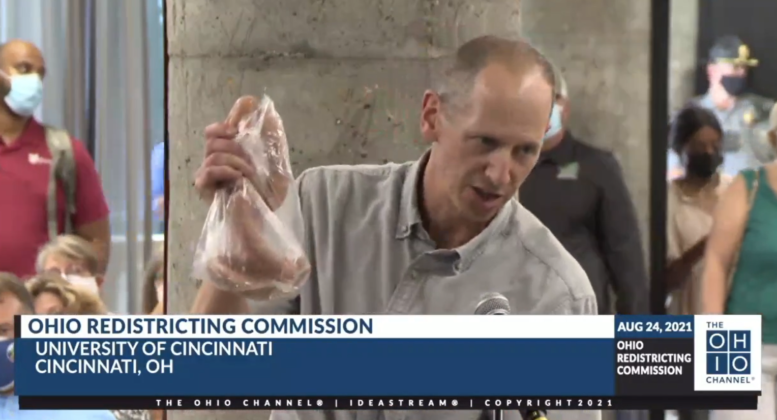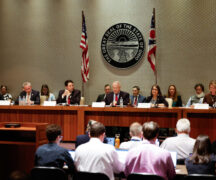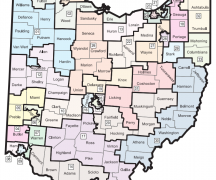BY SUSAN TEBBEN
Some of the players on the Ohio Redistricting Commission changed for their Wednesday meeting, but the amount of action did not.
The commission met to start the process of redrawing legislative maps, two days before the Friday morning deadline set by the Ohio Supreme Court.
This is the fifth attempt at legislative district lines for the commission, which has had every map approved by the commission shot down by the state’s highest court for being unconstitutional and overly partisan.
State Rep. Jeff LaRe, R-Violet Twp., took over for House Speaker Bob Cupp, and state Sen. Rob McColley, R-Napoleon, took Senate President Matt Huffman’s chair in moves both General Assembly leaders said were to clear time for other “legislative priorities,” such as the capital budget, which is due the last day in June. A federal court has set a May 28 deadline for redistricting.
LaRe didn’t speak much during the Wednesday meeting except to try to keep Fair Districts Coalition activists from interrupting, but McColley led discussions on funding appropriations and disapproval of bringing back the independent mapmakers, Dr. Douglas Johnson and Dr. Michael McDonald, to attempt to finish new legislative maps.
Those mapmakers won’t be back, as GOP members of the commission united 5-2 in the vote against the measure.
Gov. Mike DeWine echoed statements he’s made in past ORC meetings about the obligation of the commission to pass a map. But he also said the mapmakers proved in their last attempt that “they were not able to get all (the constitutional and court-ordered requirements) and avoid partisan favoritism,” and that he observed the mapmakers making decisions based on the belief that the supreme court was “requiring them to favor the Democrats.”
The Ohio Supreme Court mentioned the Johnson/McDonald map in their rejection of the fourth map passed by the ORC. In fact, they said commissioners should consider the map made by the independent duo as they make their fifth attempt.
“By certain measures,” the court majority said, the Johnson/McDonald plan “is on track to being constitutionally compliant.”
One of the sticking points the commission will face in the next two days is the impact of the legislative redistricting chaos on the second primary, set to be held in August, according to Secretary of State (and commission member) Frank LaRose.
But that primary is still up in the air, as are legislative maps, as LaRose told the commission on Tuesday he wouldn’t vote for any map considered by the commission without the promise of legislative intervention to move election deadlines.
LaRose said it would be “irresponsible” for him to consider a new map without adjusting the timelines for an Aug. 2 primary, which would hold Statehouse races and party central committee candidates.
According to a typical calendar, deadlines for an election would start 90 days before the date voters would hit precincts. In order to meet the Aug. 2 primary date, LaRose said candidate petitions would need to be validated by May 16. With Tuesday’s election considered a “miracle” by LaRose, he said he isn’t comfortable putting county boards of elections on another narrowed timeline.
As Auditor Keith Faber interpreted LaRose’s statements: “Anything we pass between now and Friday is impossible to be implemented for an Aug. 2 election no matter what we do.”
That’s where the General Assembly would come in, LaRose said. The General Assembly’s timeline would be even shorter: LaRose said he’d need an answer from legislators by Thursday to make anything election-related work.
“I would need that assurance before I could even consider a new map,” LaRose said.
That assurance isn’t likely to come, since McColley went ahead and dashed LaRose’s possibility during the Wednesday meeting. McColley told the commission he doesn’t believe his fellow state senators will support an emergency piece of legislation to change election deadlines. The legislative bodies didn’t consider moves to the May 3 primary either.
Republican legislators in the Ohio Senate, as well as Ohio House, currently enjoy supermajorities that the swing vote in recent cases — Republican Ohio Supreme Court Chief Justice Maureen O’Connor — determined as gerrymandered in 2011 as part of a then-minority of justices.
Though there was no discussion of a plan during Wednesday’s ORC meeting, shortly after it adjourned, the commission announced a 4:45 p.m. meeting on Thursday. An agenda for the meeting was not released as of Wednesday evening.
Maps are due to the Ohio Supreme Court by 9 a.m. Friday, and the federal court has said if no maps exist by May 28, they will implement the third version of legislative maps the ORC passed, which has been rejected by the state supreme court as an illegal, unconstitutional partisan gerrymander, to be used for the rest of the 2022 election.





